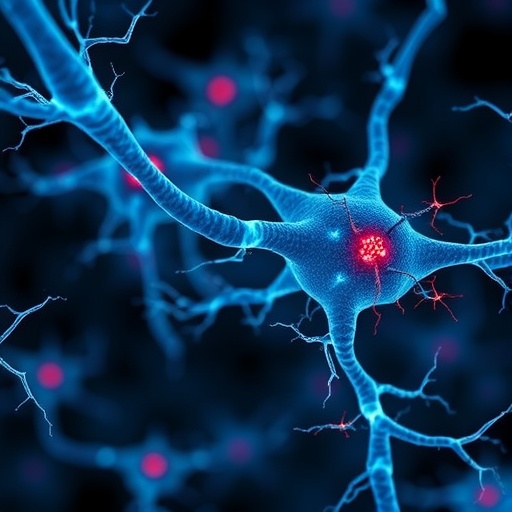In a groundbreaking study that challenges long-standing paradigms surrounding the neural substrates of anxiety and behavioral adaptation, a team of neuroscientists has identified a specialized neuronal population within the lateral hypothalamus that plays a pivotal role in counteracting anxiety, thus enabling organisms to engage in more adaptive behavioral responses. This discovery not only expands our understanding of the lateral hypothalamus beyond its classical functions but also intertwines metabolic signaling with emotional regulation, highlighting previously uncharted complexities of brain circuitry.
For decades, the lateral hypothalamus was predominantly studied for its role in orchestrating feeding behavior and energy homeostasis. However, recent advances in neuroanatomical mapping and genetic profiling have begun unveiling its multifaceted influence on affective and motivational states. The present study employed state-of-the-art molecular and optogenetic techniques to pinpoint a distinct subset of neurons within this region characterized by the expression of leptin receptors (LepR), which are traditionally associated with satiety signals and energy balance regulation. Astonishingly, these LepR-expressing neurons were found to exert a direct anxiolytic effect, effectively dampening anxiety-like behaviors in experimental models.
The research team undertook rigorous in vivo and ex vivo experiments, harnessing genetic tools to selectively manipulate these LepR-positive neurons. Functional assessments revealed that activation of these neurons results in a marked reduction in anxiety responses, as measured by multiple standardized behavioral assays. Moreover, inhibiting the activity of these neurons precipitated heightened anxiety and impaired adaptive coping mechanisms. Such findings illuminate a critical neurobiological interface where metabolic cues and emotional states converge, shedding light on the evolutionary advantage of linking energy status with behavioral flexibility.
Delving deeper into the molecular underpinnings, the investigators elucidated that leptin, a hormone secreted primarily by adipocytes, modulates the activity of these lateral hypothalamic neurons in a dopamine-influenced manner. Leptin’s engagement with its receptors on these neurons appears to alter synaptic transmission and neuronal excitability, ultimately influencing downstream pathways implicated in stress responses. This intricate crosstalk between peripheral metabolic hormones and central neural circuits advocates a nuanced perspective on how internal states shape behavior.
Crucially, the study also explored the downstream targets of the lateral hypothalamic LepR neurons, mapping their projections to other limbic and cortical structures involved in anxiety and decision-making processes. Through advanced tracing techniques, projections to the amygdala and prefrontal cortex were identified, suggesting that these neurons modulate the emotional valence of experiences and the executive control of behavior. This finding resonates with the emerging recognition of distributed brain networks as guardians of emotional regulation.
The implications of these discoveries extend beyond basic neuroscience, providing fertile ground for translational research aimed at neuropsychiatric disorders marked by maladaptive anxiety, such as generalized anxiety disorder and post-traumatic stress disorder. By manipulating the activity or signaling pathways of these specific neurons, future therapeutic strategies might achieve more precise anxiolytic effects, circumventing the limitations and side effects of current pharmacological treatments.
Another intriguing aspect illuminated by the study is the adaptive significance of this neuronal population in facilitating behavioral flexibility. In situations demanding quick shifts between vigilance and exploratory behavior, the ability of LepR neurons to temper anxiety permits organisms to assess risks versus rewards effectively. This capacity exemplifies how the brain integrates internal metabolic states with external environmental challenges to optimize survival-driven decisions.
The utilization of optogenetics in this study allowed unparalleled temporal precision in activating or silencing LepR neurons, establishing causality between neuronal activity patterns and behavioral outcomes. Such methodological rigor fortifies the conclusions drawn, positioning these findings at the forefront of neuromodulatory research. Furthermore, the researchers’ deployment of single-cell RNA sequencing enabled the characterization of the transcriptional landscape within this neuronal subset, uncovering unique gene expression profiles that might serve as biomarkers or therapeutic targets.
In light of this research, the lateral hypothalamus emerges not merely as a hub for metabolic control but also as a crucial node in emotional homeostasis and behavioral adaptation. This reframing encourages a reassessment of how hypothalamic circuits influence higher-order functions and mental health. It compels the field to explore other hypothalamic populations that might similarly link physiological states with cognitive and emotional domains.
The discovery also emphasizes the bidirectional nature of brain-hormone interactions, where peripheral signals can reconfigure central circuits in real time to align behavior with energy availability. This principle has vast implications, for instance, in understanding why metabolic disorders often co-occur with mood disturbances, and how interventions targeting metabolic pathways might ameliorate psychiatric symptoms.
Moreover, the study’s findings catalyze interest in investigating whether similar leptin receptor-expressing neuronal populations exist in humans and how they might be harnessed for clinical benefits. Given leptin’s established relevance in obesity and metabolic syndromes, this neuronal mechanism may represent a unifying link addressing comorbid conditions encompassing both metabolic and psychiatric manifestations.
Future research inspired by this breakthrough may involve intricate neural circuit dissection using emerging technologies like chemogenetics and in vivo calcium imaging to capture real-time dynamics of LepR neurons during anxiety-provoking tasks. Such approaches promise to unravel the temporal sequences and plasticity mechanisms underlying behavioral adaptation and resilience.
The study also prompts novel lines of inquiry into how environmental factors such as diet, stress, and circadian rhythms influence lateral hypothalamic LepR neuron function. Unpacking these interactions holds the potential to design lifestyle interventions that promote mental well-being through modulation of metabolic-brain axes.
In sum, this landmark investigation paves a new path in neuroscience, converging fields of metabolism, emotion, and behavior. By unmasking a lateral hypothalamic population wielding leptin receptors as a crucial modulator that counters anxiety and facilitates adaptive responses, it redefines our conception of brain function and highlights promising targets for innovative treatment avenues.
As the scientific community delves deeper into this intertwined network of physiological and psychological processes, the newfound insights bear the promise of integrated approaches tackling complex disorders at their nexus. The breadth and depth of this discovery herald a paradigm shift, steering future research towards a harmonized understanding of how body and mind collaborate to navigate the challenges of life.
Subject of Research: Neural circuits linking metabolic signals and anxiety regulation via leptin receptor-expressing neurons in the lateral hypothalamus
Article Title: A lateral hypothalamic neuronal population expressing leptin receptors counteracts anxiety to enable adaptive behavioral responses
Article References:
Figge-Schlensok, R., Petzold, A., Hugger, N. et al. A lateral hypothalamic neuronal population expressing leptin receptors counteracts anxiety to enable adaptive behavioral responses. Nat Neurosci (2025). https://doi.org/10.1038/s41593-025-02078-y
Image Credits: AI Generated
Tags: adaptive behavior and neural circuitsanxiolytic effects of leptin receptorsbehavioral adaptation and anxiety reductionbrain circuitry complexities in anxietyfeeding behavior and emotional statesgenetic profiling of neuronal populationslateral hypothalamus and emotional regulationleptin neurons and anxietyleptin receptors and affective disordersmetabolic signaling in brain functionneuroanatomical mapping of anxietyoptogenetic techniques in neuroscience





